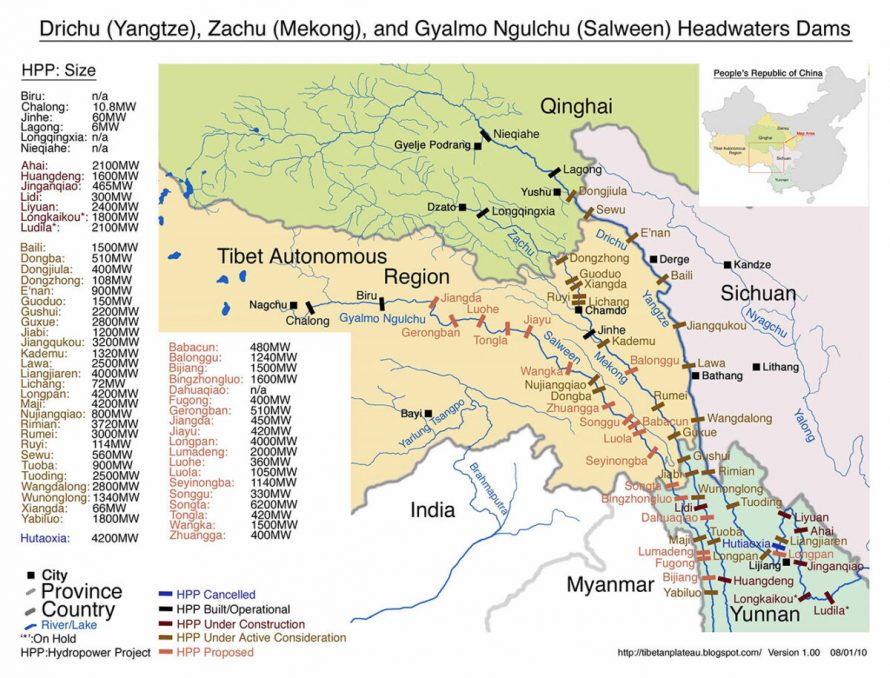A new study says the Chinese government used its dams on a major river in Tibet to prevent the flow of water downstream last year, contributing to a devastating drought in Southeast Asia.
The study from Eyes on Earth Inc. confirms what the International Campaign for Tibet and other advocates have long said: that China’s control of water in Tibet not only deprives Tibetans of their natural resources and human rights but endangers the lives of people throughout the region.
Comparing data
China has occupied Tibet—a historically independent country on the planet’s highest and largest plateau—for more than 60 years.
As the source of many of the largest river systems on Earth, Tibet provides water to more than 1 billion people across Asia.
But under Chinese rule, the supply of water from Tibet is now threatened.
The study, released on April 10, focuses on the Dzachu river, known in English as the Mekong.
Looking at data from a 28-year period starting in 1992, the study says the amount of water expected to flow naturally from the Upper Mekong was usually close to the amount that actually reached a water gauge at Chiang Saen in Thailand.
However, the study says the “relationship between gauge height and natural flow deteriorated after 2012, when a couple of major dams and reservoirs were built, which greatly restricted the amount and timing of water released upstream.”
Lowest levels ever
The situation was worst of all in 2019, when recorded river levels in the Lower Mekong were some of the lowest ever.
According to the study, there was “above-average” natural flow in the Upper Mekong at that time. But the water simply never made it past China’s dams to reach downstream countries.
“The severe lack of water in the Lower Mekong during the [summer] wet season of 2019 was largely influenced by the restriction of water flowing from the upper Mekong during that time,” the study says.
While the Chinese government was holding back water, Southeast Asian countries were facing a severe drought that robbed farmers and fishers of their livelihood and dried up parts of the river completely.
“The dams greatly expand institutional capacity to regulate the river flow,” the study notes, “with corresponding impacts downstream that need to be addressed through holistic solutions.”
ICT reports
The study affirms what the International Campaign for Tibet and other groups have been saying for years: that China’s uncontrolled exploitation of Tibet’s water represents too great a danger for the people of Southeast Asia and beyond—not to mention for Tibetans themselves.
The rising global temperatures of recent years have had an even greater impact on the melting of Tibet’s glaciers, which serve several of the region’s major rivers.
Water security is rapidly becoming a national security priority for many countries, but China’s decades-long unchecked and ruthless control of the Tibetan Plateau has put other countries at a disadvantage.
In 2015, ICT published “Blue Gold from the Highest Plateau: Tibet’s Water and Global Climate Change,” a report that chronicles how the Chinese government diverted and stemmed the flow of Tibet’s rivers to support Chinese electricity generation, mining and other economic activities.

It also describes how China has massively dammed Tibet’s rivers, including the Mekong, while at the same time refusing to join any international mechanism regulating the flow of rivers in the region, thereby depriving other countries of life-saving information.
Last year, ICT’s report, “Damming Tibet’s Rivers: New Threats to Tibetan Area under UNESCO Protection,” revealed the construction of dams and infrastructure in Tibet that could impact a biodiverse area known as the “Three Parallel Rivers,” which is the source of the Mekong.
Both reports highlight not only the destructive results of China’s policies for the Tibetan people, but also the geopolitical importance of the Tibetan Plateau for Asia and the entire world.
The study from Eyes on Earth, a US-based organization, used funding from the State Department’s Lower Mekong Initiative.